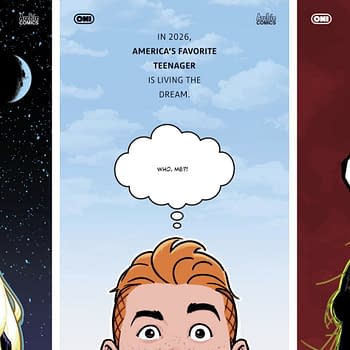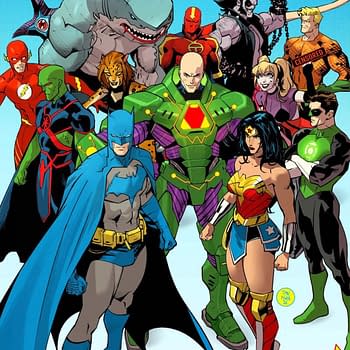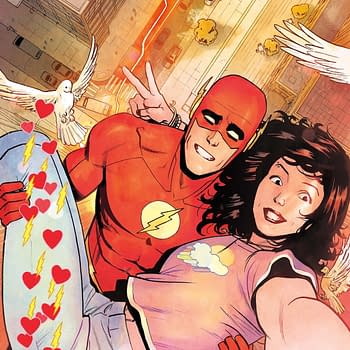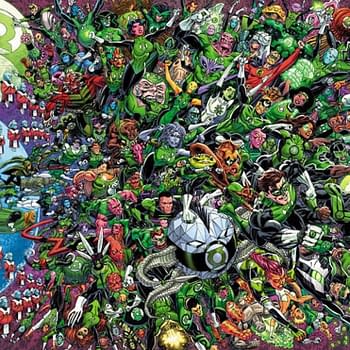Posted in: Comics, Recent Updates | Tagged: boom studios, brian bendis, Burning Fields, Comics, entertainment, Galaxy Quest: The Journey Continues, greg rucka, idw, image comics, Lazarus, michael moreci, michael oeming, powers, teenage mutant ninja turtles
Thor's Comic Review Column – TMNT #2, Burning Fields #1, Galaxy Quest #1, Lazarus #14, Powers #1
This Week's Reviews:
Teenage Mutant Ninja Turtles #2
Burning Fields #1
Galaxy Quest: The Journey Continues #1
Lazarus #14
Powers #1
Teenage Mutant Ninja Turtles #2 (IDW Publishing)
By Bart Bishop
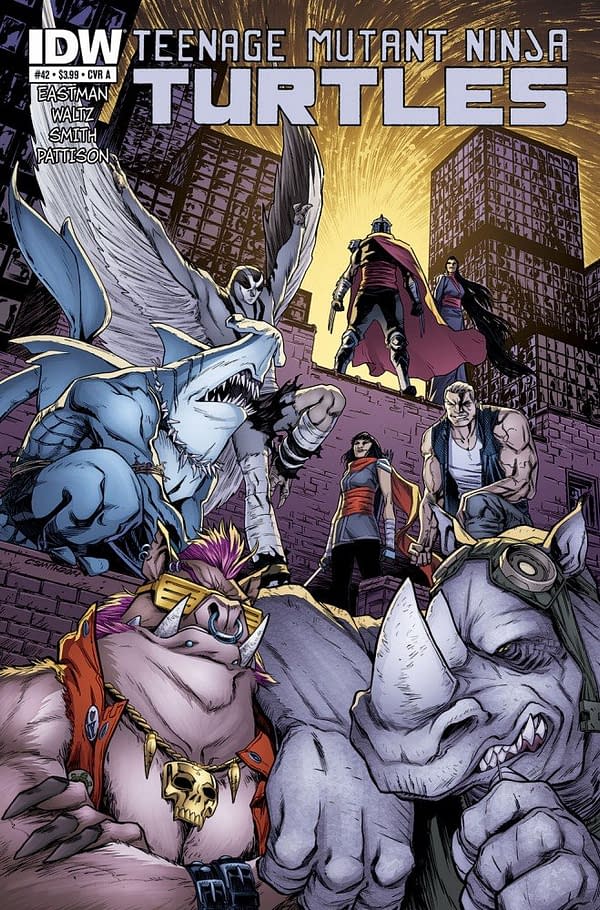
This is right in the thick of a story arc that is the culmination of several years of self-contained storytelling, but also builds on aspects of the Turtle lore that go back over 30 years. Splinter has made a deal with Hob, a cat man with an eye patch that leads a band of mutated creatures, to take down The Foot Clan headquarters while the Turtles split off, but without Donatello. He's actually been colluding with Shredder as a part of a triple-cross to aim The Foot Clan, like a gun, at General Krang and his Technodrome, pitting the two factions against each other in hopes of them destroying each other. Krang and the Technodrome are dug in on Burnow Island planning to terraform the Earth, so the Turtles hatch a scheme to position Donatello as a double agent who will teleport Shredder and The Foot directly onto the island as a distraction, leaving the diabolical battle station wide open for attack.
This is all very meticulous in its construction and while it ventures toward taking itself too seriously at times it still maintains a balance between silly and verisimilitude. There's dozens of players and opposing forces being positioned across the chess board here, and Waltz is a depth touch at keeping everything clear while ratcheting up the tension and the stakes. It's impressive that Eastman himself is still involved with this whole enterprise considering how far afield the Turtles have gotten away from him over the years, but it's appropriate that he contribute considering these characters started in comics. Waltz ventures away from the excessive violence and exaggerated bad attitudes of the original book but also doesn't fall into the slapstick camp of the original cartoon. This is more along the lines of the original movie (don't even ask, I haven't seen the new movie), but with the freedom of an infinite budget. Regardless of what version, the voices of the characters feel right, like a nicely distilled Platonic version of every previous conception.
Smith has a fine style for this kind of book. There's a sketchy cartoon feel, but with enough plasticity for a spectrum of expressions, which is key to selling the dread that permeates these pages. The Turtles themselves look inspired by the latest version of the cartoon, which I'm not overly familiar with, but the additions of new arm pads and wrappings certainly hint at that design. There's also a worn-in aesthetic that garners authenticity, with said gear and weapons looking like weathered, cracked leather and Donatello's "nerd cave" composed of exposed wire and duct tape that really speaks to the inspired eccentricity of a busy engineer. I do admit that some of the characters, like Krang and Shredder, border on being overdesigned and grimmed up in a very Call of Duty sort of way, with lots of emphasis on military weaponry, but the pulp is never lost in this concoction and that's what's important.
So while this may be my last review for about a month or so as my baby daughter will be born any day now, I can leave off knowing at least the Turtles are in good hands. This creative team hasn't forgotten the roots and the audience for these characters, something I can't say for how they're being handled in certain other mediums.
Editor and teacher by day, comic book enthusiast by night, Bart has a background in journalism and is not afraid to use it. His first loves were movies and comic books, and although he grew up a Marvel Zombie he's been known to read another company or two. Married and with a baby girl on the way, he sure hopes this whole writing thing makes him independently wealthy someday. Bart can be reached at bishop@mcwoodpub.com.
Burning Fields #1 (Boom! $3.99)
By Cat Taylor

The Burning Fields purports to be a horror comic set in the Middle East, and the first issue suffers from most of the above challenges. However, if not for the marketing synopsis, I don't think I would even classify the first issue as a horror comic. Instead, the first issue comes off as more of a crime procedural comic in a military setting. The two "horror" scenes are actually just depictions of graphic mutilation, and that alone doesn't qualify as horror to me. Horrible, yes, but "horror" in the sense of a genre, no. The rest of the story, written by Michael Moreci and Tim Daniel is focused on recruiting the story's protagonist, Dana, to investigate the events. In the process, we are introduced to a LOT of characters. I assume this is so we will have a lot of suspects to consider as the series progresses as well as a lot of cannon fodder to be mutilated. With so many characters being introduced so early, I found it difficult to get to know any of them and what I did learn made most of them seem extremely stereotypical. For instance, Dana is the run-of-the-mill female ballbuster that could be every feminist hero in every movie or TV show produced in the past ten years.
As far as the art is concerned, illustrator, Colin Lorimer, and colorist, Joana Lafuente, remind me a lot of Mike Mignola, but with more realistic looking characters. It's a good look for a horror comic, even if the horror plays a rather small role in this issue. Regardless, it works and the art compliments the story rather than distracting from it. I have the feeling this is going to come in extra handy in being able to tell all the characters apart in future issues, considering there are so many who have yet to be well defined, as I mentioned earlier.
The one thing that sets this comic apart from dozens of others is the setting of Middle East oil fields. It gives the writers the ability to incorporate a lot of real world tensions resulting from America's involvement. Resentment is shown on both sides, and there is even tension portrayed between the Iraqi civilians and their own authority figures. In addition, it appears that the mysterious mutilator is going to have ties to some terrorist group. As a result, the writers may have a deeper story evolving that will have some social commentary about the relations and tensions between the U.S. and the Middle East. To the whole creative team's credit, they previously produced the comic book, Curse, which is reputed to have redefined the werewolf sub-genre. Therefore, I have to acknowledge that despite my being underwhelmed by this first issue, the best may be yet to come.
Cat Taylor has been reading comics since the 1970s. Some of his favorite writers are Alan Moore, Neil Gaiman, Peter Bagge, and Kurt Busiek. Prior to writing about comics, Taylor performed in punk rock bands and on the outlaw professional wrestling circuit. During that time he also wrote for music and pro wrestling fanzines. He is currently rewatching "Harvey Birdman Attorney at Law" and still thinks it's funny. You can e-mail Taylor at cizattaylor@hotmail.com.
Galaxy Quest: The Journey Continues #1 (IDW, $3.99)
By Graig Kent

Beyond that, with each viewing Galaxy Quest remains a damn entertaining movie. It continues to take the familiar, lovingly deconstruct it, and rebuild it into something of its own. It has a harder time existing outside the context of Star Trek, but it still does quite well on its own. The characters were the key. As actors trying to truly inhabit the roles they once played, each character reacted differently to the responsibility placed before them, and the viewer, knowing the stakes, invested greatly in their ability to pull through. It's a remarkable movie, a top-tier sci-fi comedy on the level of Ghostbusters, virtually perfect for its time. It's brilliantly self-contained, with no real set-up for a sequel, nor any real need, but with the likeability of the characters, the sheer joy of the experience, one can't help but yearn for more of the same.
15 years later, there's still no sequel (though the rumours are percolating) but where there's a fanbase desiring more, if perhaps not enough of one to risk sinking tens of millions of dollars into producing a film, there's always comics. Taking its name from the "Next Generation"-style revival TV series as shown at the end of the movie, Galaxy Quest: The Journey Continues is the second mini-series that IDW has produced from the property ("Global Warning" was the first in 2008). The series opens on an alien planet, where a rebellious faction is about to get the upper hand on their techocratic overlords, but at the same moment of their victory, Jason Nesmith activates the Omega 13 device and resets time by a handful of seconds, just enough for the technocrats to stave off the attack. The fleeing rebels, aware of what has occurred, seek out the instigators of this fatal deja vu.
Cut to the modern day (at least a few years after the film, though it doesn't quite seem 15 years later), and they have been found, or at least they've traced the Thermian technology back to Earth, particularly to Brandon (Justin Long's character in the film) who seems to be the only person maintaining contact with the aliens (and using their advanced technology to further his own career). The cast of "Galaxy Quest" are reaping the rewards of many successful seasons of "The Journey Continues", writer Erik Burnham smartly rehashes the film's ComicCon-style panel setting as a means of exposition for how they've fared these past few years. After the panel, back stage, Burnham captures the rhythms of the characters nicely — their selfishness and bickering, primarily, but also their lingering camaraderie — but he makes a painful misstep by transporting Brandon from his office to the convention center parking garage without showing us a transition scene aboard the Protector. This is a comic, it shouldn't have to skimp on the effects.
By and large Burnham has a good handle on the Quest crew, and has a fairly enjoyable idea for a story to bring them all together again (it's intriguing that the Omega 13 didn't just affect what was happening aboard the Protector, but the entire galaxy…what else could have been different?). Although there's no solid laughs, at least not yet, Burnham elicits some smiles with his script, the warm feeling of recognizability, and the welcoming presence of familiar terrain. What holds this comic back from feeling like a genuine sequel is the art.
I get that with a marginal success like Galaxy Quest, the likenesses of the actors don't accompany the rights to the property, so the characters have to be designed to be similar to Tim Allen, Sigourney Weaver, Alan Rickman, et al. but not look exactly like them. I can get past that. But Nacho Arranz hasn't designed very distinctive or memorable characters to replace them. They're all thin, lean faces that are barely distinguished by hair, gender or skin colour. Their expressions look unnatural, painfully pulled and rubbery. Every image of a character smiling is unintentionally sinister, borderline nightmarish. Beyond that, the characters physical movements are clunky and awkward, looking like marionettes, like their limbs are on strings. Arranz does a great job with settings — he can draw the hell out of a parking garage — but the characters are the lifeblood of the story. When so much of the book hinges upon dialogue you need a charming face delivering the words, not some grotesquely contorted mug that's not quite consistent from one panel to the next. Arranz is a young professional, and needs to evolve from his Zenescope house style, and by then end of this mini-series he just might, but I don't know if I can stomach watching the evolution. I really don't like to be so negative, but the art genuinely hindered my enjoyment of what would otherwise be a welcome continuation of a rather cherished film.
Graig Kent's first novel, Quarter City, can be read for free on Wattpad []. It's about a fictional city dealing with people with special abilities. You might like it. Graig tweets stuff @thee_geekent and he does various other things in other places.
Lazarus #14 (Image)
By Adam X. Smith

Whilst it's complex backstory is probably more worthy of a recap than most due to it taking place in a dystopian future that reads like Game of Thrones meets Gattaca, the basic setup for issue #14 is pretty straightforward by this series' standards. Forever Carlyle, genetically engineered one-woman-army of the Carlyle family, has been tasked by her father Malcolm with absconding with her estranged brother Jonah, who has been held ransom by rival patriarch Jakob Hock, and killing him, thus taking away Hock's leverage in the negotiations taking place between the families on Triton One, a converted oil rig in the North Sea that acts as both a leisure resort for the super-rich ruling families and as a neutral ground for the conclave.
However, what should have been a simple mission is complicated by Forever's own growing questions regarding her true parentage, and Jonah's pleas for mercy combined with the revelation that their sister Johanna is not all she appears to be lead Forever to go against her orders (as well as some serious mental conditioning) and let Jonah escape.
The rest of the issue is pretty much just setting up the inevitable confrontation between Houses Hock and Carlyle, with Forever being forced to duel a fellow Lazarus champion to the death – in this case, Sonja Bittner, who over the course of the arc has gone from being a potentially sinister harbinger of ill tidings in her first appearance to a bubbly and friendly support character in later issues, making her almost certain death at the hands of Forever all the more heart-breaking. Will being forced to kill the blameless Sonja be the straw that breaks Forever's allegiance to her family? Will Rucka, anticipating the blowback, have Forever spare her, precipitating an even more abrupt break from the family, future feudal law be damned? Will she go cold turkey from the drugs being used to manipulate her, and if so what potential side effects will there be? Time will tell.
Writing this column, I find myself somewhat at a loss. The structure of Lazarus as a series is predicated very much on five-issue, character heavy story arcs, with brief intermittent explosions of short, sharp violence punctuating them, and the aforementioned complex nature of the series' world makes summarizing it problematic (see, the Game of Thrones comparison was apt). I might just as well try to explain the appeal of a random issue of Sex Criminals to the initiated, for all the good it would do.
The telegraphed nature of Sonja's potential demise also has me wary, as Rucka previously pulled a very similar trick (twice, no less) during issue #9, the final part of the previous arc, and whilst every instinct in my mind is convinced that Rucka isn't a big enough troll to pull the same bait-and-switch a third time, that occasion elicited a combination of relief and annoyed puzzlement that no-one "good" had died.
However, I wouldn't have spent this long struggling to reach some arbitrarily acceptable article length trying to sing its praises unless Lazarus was still one of the best creator owned series currently being released, is one of the most rewarding and rich examples of world-building in comics, and has a female protagonist who rivals most superheroes for the title of Most Badass Motherf*cker In The Room. Sure, it's not exactly an easy jumping-on point and it relies heavily on the audience already being on board, but that's all the more reason to get on board as soon as possible: it's not merely the premise but the execution of it that keeps me coming back. George R.R. Martin's skill as an author, and the source of his power over his audience, doesn't simply come from randomly killing off a character every couple of hundred pages to keep things interesting; it comes from making us care whether they live or die, making us mentally plead with him for clemency, in the vain hope the sword of Damocles won't fall this time.
I'm Adam X. Smith. Valar morghulis.
Powers #1 (Marvel/Icon, $3.99)
By Jeb D.

And thus we come to the latest Powers reboot, timed to coincide with the Powers TV series coming to Sony PlayStation (which means I won't be seeing it anytime soon, though doubtless Sony has plans to molest my wallet later on with a Blu-ray release). Refreshingly, there doesn't seem to have been a huge kerfuffle about the series' color-swapping of Deena Pilgrim (though I'd love to see what Lucy Punch might have done with the character); certainly, the TV casting allows Brian Bendis and Michael Oeming to resist the obvious conclusion that they've rebooted the comic for the sole purpose of moving it in lockstep with the TV series, by bringing their strongest character front and center, even if her complexion might confuse viewers of the TV series. Issue #1 reinforces that immediately by being thoroughly Deena-centric, bringing us up to date on what's happened since the end of the Powers Bureau variation. Her remaining a cop is a bit of a logical leap, but the plausibility's not stretched too far. The fact that she's written a best-selling book based on her experiences helps with the idea that she's put the previous series' events behind her, and is ready for a fresh start.
As the story proper gets underway, Deena and detective Enki Sunrise are investigating a particularly grisly powers-related massacre on a luxury yacht, seemingly perpetrated by a character we only see as a familiar-looking silhouette. It's easy to forget (as some of the bonus art material in the backmatter reminds us) that Christian Walker, not Deena Pilgrim, was originally Powers' central character. In the letter column, Bendis reiterates his belief in allowing characters to grow and take on their own lives, and it's clear that, of all the strong female characters he's given us (including Scarlet, Jessica Jones, and even Layla Miller), he's found enough in Deena Pilgrim to stick with her for fifteen years and counting. Oeming loves her too, of course, as the fantastically kinetic, and hysterically funny, opening shootout sequence testifies; no other character in comics makes the rapid-fire back-and-forth of Bendis' dialog work the way that Pilgrim does, and it would be easy to imagine her carrying this latest version of Powers on her own.
Which points up the biggest weakness of the first issue: we don't meet our other principal cast member till the final page, and from all appearances, we're going to be telling yet another story of Christian Walker's world-weary reticence (which too often just comes off as sulking). When we do finally encounter him, he's evidently descended into a self-pitying funk (the kind where you slouch around a skeezy strip club with a beer gut poking out of your hoodie). After all we've seen Walker go through, from prehistoric monkey sex to intergalactic space patrolling, the longtime reader is tempted to tell the guy to either get his shit together once and for all or get lost. Walker's redeeming feature has always been his interplay with Pilgrim, and her ability to bring out his humanity; once that's re-established, this latest Powers series will be better able to hit its mark. Apart from the question of whether Sunrise's presence will confuse TV viewers (she obviously looks a lot more like Susan Heyward than Deena does), she's also a kind of an awkward third-wheel in the Walker-Pilgrim relationship, with her "take no shit" attitude coming off as redundant in comparison to Deena's. Presumably, in the new series, she'll continue to function as the new reader's surrogate, but I'd like to see her step out of that shadow as soon as possible.
Mike Oeming has sometimes seemed to be the principal thing keeping Powers' weaker runs from disappearing completely up Bendis' ass: he can do both criminal and cosmic in a style that's deceptively cartoony, but as tough-minded, in its own way, as a Sean Phillips or Jason Latour. His visual sense remains a delight—the flashy action that opens the book is followed by a dark, evocatively wordless sequence highlighting Deena's (evidently justified) paranoia. The two-page tour he gives us of the police station is a great example of how rewarding it can be to "read" a comics page regardless of the dialog. I don't know exactly when Oeming switched from pencils to digital artwork, but (as I noted in my review of the first issue of United States of Murder Inc), I sense a kind of rushed quality to some of his work these days (granted, he's busier than ever now); his fantastic eye for detail remains intact (and, as usual, there's superhero Easter eggs and in-jokes galore), but there seems to be a bit more inconsistency in areas like character design and facial expression than I remember from Powers' earliest days. That may just be my perception and it's nitpicking, anyway: Powers is still one of the best-illustrated comics around.
Like a great TV series, Powers succeeds less on plot than when it sends sparks up from the relationship between Walker and Pilgrim. Once we get past the obligatory "shake Walker out of his funk" story arc, I'm up for what comes next.
Jeb D. says "Congratulations, Bart: daughters are amazing."











